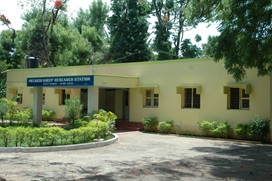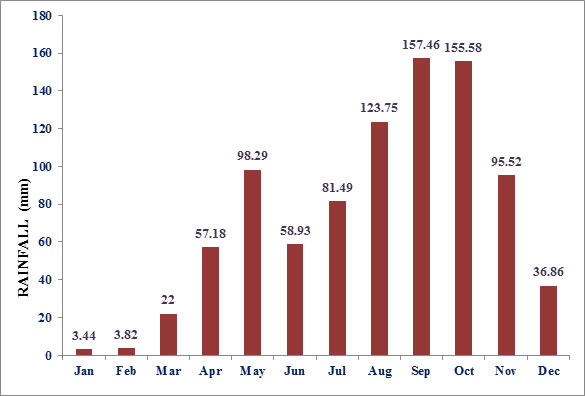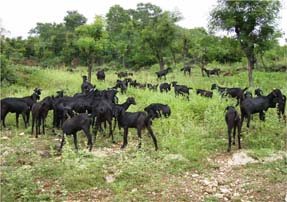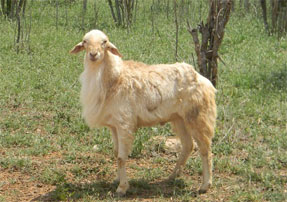The origin of this station could be linked to the implementation of an ICAR funded research scheme on "Studies on carcass characteristics of Mecheri and Mandya lambs" at Alamarathupatti village of Kolathur Block in Salem district from 12.02.1971. The Mecheri Sheep Research Station was started on 05.06.1978 at Pottaneri Panchayat of Mecheri Block in Salem district with the aim of improving the Mecheri sheep which was considered to be the best indigenous mutton breed of Tamil Nadu.

This research station is situated in Salem –Mettur highway about 35 km west of Salem and 15 km east of Mettur at a longitude of 77° 56’E, latitude of 11° 45’N and altitude of about 650 feet above MSL. This station covers an area of 164.36 acres.
The soil profile of this area is loamy in the plain and rocky in the hills. The average annual rainfall is about 894 mm. The rainy season commences from July and continues till the end of November. The average maximum and minimum temperatures are 34.3°C and 21.9°C respectively.
| Average monthly rainfall recorded at Mecheri Sheep Research Station, Pottaneri | |
|---|---|
| Months | Average (1983 to 2017) |
| January | 3.45 |
| February | 3.83 |
| March | 22.00 |
| April | 57.19 |
| May | 98.30 |
| June | 58.93 |
| July | 81.50 |
| August | 123.75 |
| September | 157.46 |
| October | 155.58 |
| November | 95.53 |
| December | 36.87 |
| Annual Rainfall | 894.38 |

| TITLE | FUNDING AGENCY | DURATION | TOTAL COST (lakhs) |
|---|---|---|---|
| Survey, evaluation and characterization of Mecheri Sheep breed | ICAR | 1.04.2000 to 31.03.2002 | 11.73 |
| Effect of neem (Azadirachta indica) feeding on reproductive and productive performance of Tellicherry | ICAR | 01.10.2002 to 31.09.2006 | 8.03 |
| Establishment of modern Salem black goat unit and optimize the feeding standards for economical production in dry land tract. (Part – II Scheme) | Government of Tamil Nadu | 01.11.2011 to 31.12.2013 | 12.55 |
| Popularizing model fodder seed bank at farmers field to augment fodder production (NADP Scheme) | NADP-RKVY, Government of Tamil Nadu. | 06.01.2012 | 19.45 (MSRS 6.082) |
| Improving Socio - Economic status of Scheduled tribes through backyard chicken rearing | ICAR | 23.11.2012 30.03.2013 25.02.2014 |
2.00 0.25 0.30 |
| Soil and mineral mapping in farmers field and sensitizing them to improve biomass and to augment livestock productivity | State Planning Commission, Tamil Nadu State Land Use Research Board, Government of Tamil Nadu, Chennai | 16.05.2013 | 3.00 (0.15) |
| Soil- Fodder – Livestock Interface To Augment Productivity (Phase I) | State Planning Commission, Tamil Nadu State Land Use Research Board, Government of Tamil Nadu, Chennai | 2014 to 2015 | |
| Central sector scheme on ‘Biotech centre for fecundity genes’ | GOI – Integrated Development of Small Ruminants and Rabbits | 21.05.2012 to 31.03.2016 | 19.99 |
| TITLE | FUNDING AGENCY | DATE OF START | TOTAL COST (lakhs) |
|---|---|---|---|
| Mega sheep seed project Mecheri sheep | ICAR - Central Sheep and Wool Research Station, Avikanagar, Rajasthan. | 01.04.2009 | 269 lakh Continuing scheme |
| Revolving fund scheme on Commercial Salem Black goat rearing | TANUVAS, Chennai-51 | 11.08.2016 | 70,000 |
| Revolving fund scheme on Fattening of Mecheri Ram lambs | TANUVAS, Chennai-51 | 30.03.2017 | 1,05,000 |
| Establishment of Vermicomposting unit in MSRS | TANUVAS, Chennai-51 | 30.03.2017 | 30,000 |
| Revolving fund scheme on Fattening of Salem Black kids | TANUVAS, Chennai-51 | 02.08.2017 | 80,000 |
| ICAR - Veterinary type culture - Tribal sub plan | Indian Council of Agricultural Research | 01.04.2015 | 4.00 |
Nucleus flock of Mecheri sheep breed is being maintained at this station to carryout various genetic improvement programmes and to supply superior germplasm to the farmers.
Mecheri sheep are distributed in Salem, Namakkal, Erode, Karur and parts of Dindigul and Dharmapuri districts of Tamil Nadu. The name Mecheri has been derived from its place of origin i.e., Mecheri block in Mettur taluk of Salem District. The place Mecheri is said to be derived from “Mechal Eri” (Mechal - grazing of sheep and Eri-pond). The Mecheri sheep has other synonyms like Thuvaramchempuli, Maiylambadi and Kannivadi. Mecheri sheep with typical morphological features are seen in Tharamangalam, Omalur, Kolathur and Mecheri blocks of Salem district.
Mecheri sheep are medium sized animals with compact body and covered with short hairs, which are not shorn. They are light brown in colour. The profile is slightly Roman nose. Mecheri sheep is classified under polled breeds of sheep. Both males and females are polled. The legs are medium sized, straight and medium in length, squarely set under the body. The hooves are brown or black in colour. Udder is not well developed. It is small and round, tightly attached to the belly with small conical teats placed laterally. The teats are directed slightly outward.
The leather made from Mecheri sheep skins have higher tensile, tear and grain crack strengths as compared with leather made from mixed origin. With regard to organoleptic properties of skin, the Mecheri skin is better in quality in terms of softness, grain tightness, fullness, surface smoothness, and uniformity of colour and general appearance. The hand evaluation assessment and strength characteristics determination reveals that the Mecheri sheep skins are superior and are suitable for higher quality garment or upper valued leathers. The special features of this breed are early sexual maturity, superior skin quality and high dressing percentage ( Read more... )
Nucleus herd of Salem Black goat breed has been maintained at this station to implement genetic improvement programmes and to supply superior germplasm to the farmers.
Salem Black goats are distributed in north-western agro climatic zone of Tamil Nadu and are reared mainly for meat. The name “Salem Black” has been derived from its place of origin and coat colour. The name Salem has been derived from the place called Salem (i.e., Salem districts of Tamil Nadu), where this breed has been actually originated. Since, this breed is completely black in colour; called as Salem Black goats. It has synonym viz., Karuppuadu. They are mainly distributed in Salem, Dharmapuri, Krishnagiri and adjoining areas of Erode and Namakkal districts. Salem Black goats with true-to-type are present in Mettur and Omalur taluks of Salem district as well as Pennagaram, Palakkodu and Harur taluks of Dharmapuri district.
Salem Black goats are tall animals with lean body and the coat colour is completely black in colour. The head is medium in length with medium to broad forehead. The ears are medium in size, leaf like and semi-pendulous. In adults, both males and females have horns and they are ash grey to grey in colour with no typical horn pattern. They have long, lean and straight legs squarely set under the body. The hooves and dewclaws are grey in colour. The tail is thin, medium in length and curled upwards. Males have fairly long, straight and rough hairs on the neck and withers and all other parts have short and soft hairs. Udder is not well developed. It is small and round and tightly attached to the belly with small conical teats placed laterally.
Salem Black goats have considerable production potential under semi-arid, tropical conditions of north-western agro-climatic zone of Tamil Nadu. The distinguishing features of this breed are early sexual maturity, better adaptability to harsh climatic condition and higher prolificacy ( Read more... )
In pasture section different pasture fields has been established with grasses and legumes as well as different fodder trees have been grown to meet the fodder production of this station. For effective water utilization different micro-irrigation systems have been used.
Pasture fields : Cenchrus ciliaris, Guinea grass (Panicum maximum), Stylosanthes hamata and Stylosanthes scabra
Irrigated fodders: Cumbu Napier hybrid (Co-4), Cumbu Napier hybrid (Co-5), Guinea grass, Guinea grass-GG3, Desmanthus spp., Co FS 29, Australian Red Napier, Andhra Pradesh Napier.
Rain fed crops : Horse gram, Sun hemp, Cow pea, Sorghum, Groundnut, Cumbu and Ragi
Fodder trees : Neem, Glyricidia, Vagai, Agathi, Kapok, Kodukapuli, Velvel, Teak, Subabul, Tamarind, Puvarasu and Moringa.
The fodder slips and different fodder seeds are sold to the farmers. ( Read more... )
A model fodder plot with various fodder varieties has been established at this station. The different fodder seeds and slips have been sold to the farmers ( Read more... )
A tree nursery has been established and maintained at this station with different fodder tree saplings. Different fodder tree saplings have been sold to farmers for increasing fodder production ( Read more... )
Herbal garden has been established at this station for maintaining important herbal plants for conservation and to supply the original herbal varieties to the needy farmers. At this station, around 100 important herbal plants have been established and maintained. The herbal plants are sold to the farmers ( Read more... )
A vermicompost unit has been established and maintained for the production and supply of earth worms and vermicompost to cater the needs of the station as well as farmers.
Vermicomposting is the process of degradation of organic wastes by earthworms to achieve three objectives viz.,
Any type of containers can be used. The number of earthworms will depend on the container size. A volume of 0.3 m3 (1 m x 1 m x 0.3 m ) can accommodate 2000 worms. The container can be constructed in brick masonary and cement, wood or even plastic trough can be used. Composting has to be done under a roof to avoid direct sunlight and rain.
In Mecheri Sheep Research Station, Pottaneri, three different types of vermicompost models have been established for demonstration to the farmers and vermicompost production. The earthworm Eudrillus eugeniae is used in all the three models. The vermicompost and earth worms are sold to the farmers ( Read more... )
Azolla unit has been established with different models for the propagation of Azolla as a fodder among the farming communities in and around this station. Azolla (Azolla sp.) is an aquatic fern consisting of a short, branched, floating stem, bearing roots which hang down in the water. The leaves are alternately arranged, each consisting of thick aerial dorsal lobe containing green chlorophyll and a slightly larger thin, colourless, floating ventral lobe. Plant diameter ranges from 1.0 to 2.5 cm for small species such as Azolla pinnata and 15 cm or more for Azolla nilotica. Azolla plants are triangular or polygonal in shape, and float on the surface of the water, individually or in mats. The most remarkable characteristic of azolla is its symbiotic relationship with the nitrogen-fixing blue-green alga (cyanobacterium) Anabaena azollae. The fern provides nutrients and a protective cavity in each leaf to Anabaena colonies in exchange for fixed atmospheric nitrogen and possibly other growth-promoting substances. Water is the fundamental requirement for the growth and multiplication of Azolla as the plant is extremely sensitive to lack of water. Although Azolla can grow on wet mud surfaces or wet pit litters, it prefers a free-floating state. Azolla grows best in full to partial shade (25 to 50 per cent of full sunlight). Growth decreases quickly under heavy shade (lower than 1500 lux) and more than 50 per cent of full sunlight reduces photosynthesis. The optimum relative humidity for azolla growth is between 85 and 90 per cent. Azolla becomes dry and fragile at a relative humidity lower than 60 per cent. Successful cultivation of azolla requires the application of a certain amount of phosphorus fertilizer (0.5 to 1.0 kg P/ha/week). Three different azolla units have been established for demonstration and also for utilization as a feed for the animals maintained in this station. Azolla seeds have been supplied to the farmers for establishment in their premises ( Read more... )
In order to promote roof top vegetable garden in urban areas, a model vegetable garden unit has been established for demonstration to the farmers. Roof gardens are most often found in urban environments. Available gardening areas in cities are often seriously lacking, which is likely the key impetus for many roof gardens. The garden may be on the roof of an autonomous building which takes care of its own water and waste. Plantings in containers are used extensively in roof top gardens. At Mecheri Sheep Research Station, Pottaneri, the vegetable plants are kept in specific pots for demonstration as well as vegetable production ( Read more... )


| Body weight (kg) of Mecheri Sheep | ||||
|---|---|---|---|---|
| Sex | Birth weight | Weaning weight | 6- months weight | 12 months weight |
| Male | 2.35 ± 0.36 | 11.13 ± 0.20 | 15.67 ± 0.27 | 19.56 ± 0.66 |
| Female | 2.38 ± 0.22 | 10.10 ± 0.12 | 13.31 ± 0.25 | 15.13 ± 0.59 |
| Overall mean | 2.36 ± 0.21 | 10.60 ± 0.11 | 14.45 ± 0.19 | 17.21 ± 0.44 |
| NAME | THESIS TITLE | YEAR |
|---|---|---|
PhD - THESIS RESEARCH |
||
| Dr.K.Karunanithi | Studies on cryopreservation of Ram Semen | 1994 |
| Dr.V.Jeichitra | Genetic analysis of growth traits in Mecheri sheep | 2006 |
| Dr.G. Selvaraju | Development of diseases forecasting system against diseases of small ruminants | 2007 |
| Dr.K.Arunachalam | Epidemiology and metaphylaxis of subclinical coccidiosis in small ruminants | 2007 |
| Dr.D.Rajendran | Optimising microbial protein synthesis through dietary manipulation in forage based diet of Mecheri Sheep | 2007 |
| Dr.A.Sudhakar | Molecular Study on BMP-1B, IGFBHP-3 and POU-1F1 genes in Mecheri and Nilgiris Sheep | 2007 |
| D.Jayanthi | Studies on growth performance, carcass characteristics and meat quality of Salem black goat | 2012 |
| Dr.D.Cauveri | Genetic variability of growth hormone and Leptin gene and their association with growth traits in sheep breeds of Tamilnadu | 2013 |
| Dr.R.Chitra | Polymorphism of IGF-1,BMP and CAST genes and their association with growth traits in Madras Red and Mecheri sheep | 2013 |
MVSc - THESIS RESEARCH |
||
| Dr.R.Selvakumar | Effect of Supplementation of protein and growth promoter on growing lambs on slatted floor | 2003 |
| Dr.R.Karthick | Effect of herbal feed supplementation on the performance of grazing lambs | 2010 |
| Dr.S.Rajasokkappan | Epidemiology and metaphylaxis of subclinical coccidiosis in small ruminants | 2010 |
| Dr.C.Balan | Statistical modelling of growth performance in Mecheri sheep | 2014 |
| Dr.R.Santhoshkumar | Early weaning performances in Mecheri sheep | 2017 |
| Dr.S.Senthilmuthukumararn | Impact assessment of Mega Sheep Seed Project | 2017 |
MSc - THESIS RESEARCH |
||
| M.Mohanasundari | Studies on Biochemical profiles of Malabari goats in relation with age and sex | 2001 |
| M.Rameshkumar | Influence of Age and Sex on Biochemical profile of Mecheri Sheep | 2001 |
Dr. J.Muralidharan, Professor and Head | muralidharan.j@ tanuvas.ac.in | Mobile: +91-9443517695
Dr. N.Sribalaji, Assistant Professor | sribalaji.n@tanuvas.ac.in | +91-9345304334
Dr. P.Senthilkumar, Assistant Professor | senthilkumar.p@tanuvas.ac.in | +91-9943936811
Dr. V.Sankar, Assistant Professor | sankar.v@tanuvas.ac.in | Mobile: +91 – 9585689018
Dr. P.Nalini, Assistant Professor | aishvet@gmail.com | Mobile: +91 - 9786453279
Dr. L.Arun, Assistant Professor (External Deputation for PhD)
The Professor and Head,
Mecheri Sheep Research Station,
Pottaneri – 636 453,
Salem District.
Phone: +91-4298 - 262023
E-mail : msrs@tanuvas.org.in